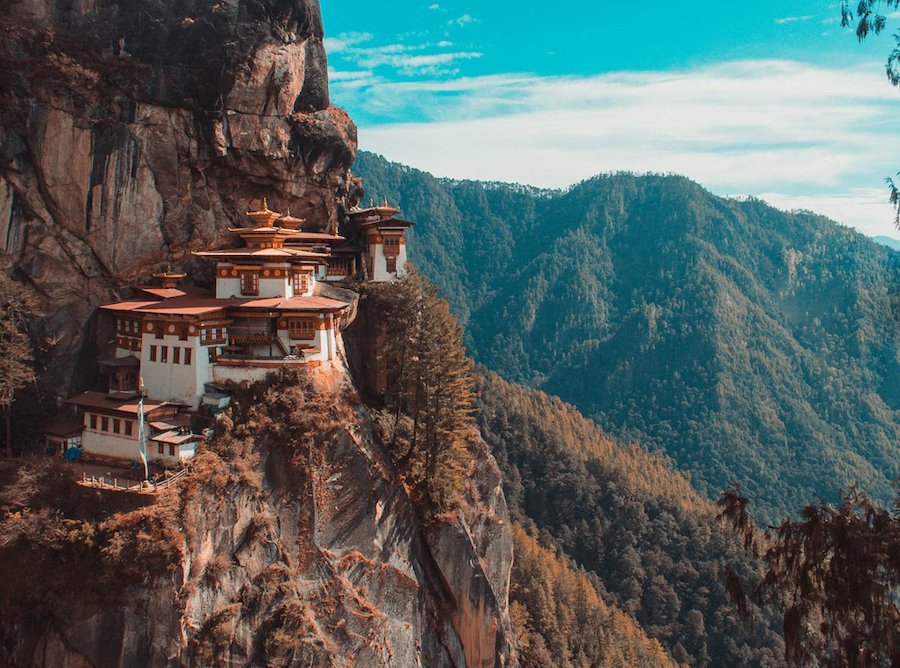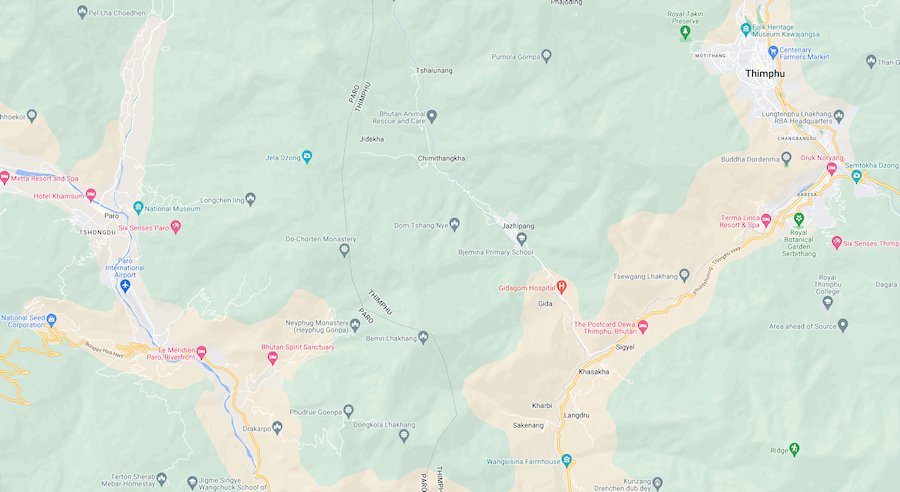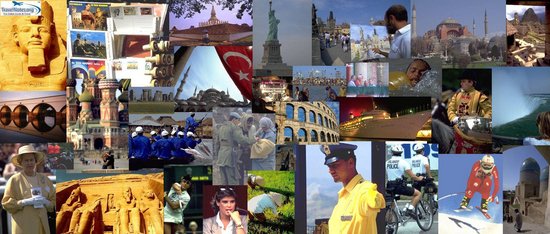Travel Notes: Asia - Bhutan Travel Notes.
Short URL: https://tnot.es/BT
Bhutan Travel and Tourism on Travel Notes
Uncover the Mystical Beauty of Bhutan - Journey to Happiness
Embark on an adventure to Bhutan. Discover ancient traditions, breathtaking landscapes and the secret of happiness in this enchanting Himalayan kingdom. Share on Facebook
About Bhutan
Visitors to Bhutan can experience stunning mountain landscapes, vibrant cultural heritage, the natural environment and a traditional way of life.
All visitors to Bhutan are required to book their travel through a licensed tour operator in Bhutan. The tour packages typically include transportation, accommodation, meals, and a guide, and can cost between $200 to $250 per day, depending on the season.
 Add a Business -
Add a Location -
Add a Lodging - Add Travel Content
- Add URL
- Travel Services.
Add a Business -
Add a Location -
Add a Lodging - Add Travel Content
- Add URL
- Travel Services.
Mapping Bhutan
Map of Bhutan
The Kingdom of Bhutan is locked in the Himalayas, between India and Tibet.
Bhutan Background Information:
Compiled for Travel Notes, with the help of Yves Fortin.
Bhutan Overview
Bhutan is a small landlocked country in South Asia, located in the eastern Himalayas.
It is known for its unique culture, stunning natural beauty, and commitment to preserving its environment and culture.
Bhutan Culture
The culture of Bhutan is strongly influenced by Buddhism, which is the predominant religion in the country.
The people of Bhutan are known for their hospitality, and traditional dress is still worn by many people.
Bhutanese festivals, or tshechus, are colorful and vibrant events that celebrate the country's religious and cultural traditions.
Bhutan Tourists
Tourism is a growing industry in Bhutan, but the government limits the number of visitors to the country in order to preserve its culture and environment.
Visitors to Bhutan must pay a minimum daily tariff, which includes accommodation, meals, transportation, and a licensed guide.
The government also requires tourists to have a visa and to book their trip through a licensed tour operator.
Environmental Conservation
Bhutan is known for its strict environmental conservation policies.
The country's constitution mandates that at least 60% of its land must be covered by forest, and the government has banned logging and the export of timber.
Bhutan is also a carbon-neutral country, meaning it absorbs more carbon dioxide than it produces.
Gross National Happiness
Bhutan is the only country in the world that measures its progress in terms of Gross National Happiness (GNH) rather than Gross Domestic Product (GDP).
The concept of Gross National Happiness was introduced by the fourth king of Bhutan in the 1970s, as a way to ensure that the country's development was sustainable and benefited its citizens' well-being.
Visiting Bhutan
Only a lucky few thousand people, who can afford to spend two hundred dollars a day, thanks to the Government Tariff, get to visit the kingdom of Bhutan in a year.
The policy of restricted tourism is meant to safeguard the culture and ideals of an Himalayan kingdom that doesn't want to make a killing from tourism, especially if it is the tourism that kills their way of life.
The modern name for the country comes from the Sanskrit word Bhu-Uttan, meaning High Land, although the Bhutanese refer to their country as Druk Yul - the land of the Dragon.
The indigenous people are Drukpas and they follow the Drukpa Kagyud school of Buddhism.
Visit Bhutan
Bhutan is a beautiful and unique country nestled in the Eastern Himalayas, known for its stunning natural scenery, rich cultural heritage, and commitment to Gross National Happiness.
Tips For Visitors to Bhutan
Bhutanese Cuisine
Bhutanese cuisine is largely influenced by Indian and Tibetan cuisine, and features a variety of spicy dishes made with rice, vegetables, and meat.
Cost
Bhutan operates a high-value, low-impact tourism policy, which means that visitors must pay a minimum daily tariff.
The tariff covers accommodation, meals, transportation, and an English-speaking guide.
The cost varies depending on the time of year and the level of accommodation, but it generally ranges from $200 to $250 per person per day.
Cultural Experiences
Bhutan is known for its vibrant cultural heritage, which includes traditional festivals (tsechus), archery, and local handicrafts such as weaving, painting, and woodcarving.
Places to Visit in Bhutan
Bhutan has many beautiful places to visit, including the Paro Valley, Thimphu (the capital city), Punakha Dzong, Tiger's Nest Monastery, and the Haa Valley.
Respect Local Customs
Bhutan is a deeply religious country, and visitors should be respectful of local customs and traditions.
This includes dressing modestly and removing shoes before entering religious sites.
Sustainable Tourism
Bhutan is committed to sustainable tourism, and visitors are encouraged to minimize their environmental impact by using eco-friendly products, conserving water and electricity, and respecting local wildlife and ecosystems.
Trekking in Bhutan
Bhutan is a popular destination for trekking, with a range of trails for all levels of experience.
Some of the most popular treks include the Jomolhari Trek, the Druk Path Trek, and the Snowman Trek.
Visa
All visitors to Bhutan require a visa, which must be arranged through a licensed Bhutanese tour operator or travel agent.
The visa fee is included in the tour cost.
When to Visit Bhutan
The best time to visit Bhutan is from March to May and from September to November, when the weather is mild and the skies are clear.
In May, the weather is glorious, and the colours and the smell of flowers are everywhere you turn.
Visit Bhutan in the month of May, when it is considered off season.
Wildlife in Bhutan
Bhutan is home to a variety of wildlife, including tigers, leopards, and elephants.
Visitors can go on wildlife safaris in areas such as the Royal Manas National Park.
Where to Go in Bhutan
Map of Paro and Thimphu
Bhutan Itinerary
A typical program for foreign tourists to Bhutan will include visits to a number of dzongs, particularly in western and central Bhutan. Dzongs are very much at the centre of civil, religious and cultural life in Bhutan.
The capital of Bhutan is Thimphu, located in a sylvan valley on the bank of the River Thimpu.
Bhutan Soul Tours and Travel
Bhutan Soul - In a world that is always on the go, Bhutan offers a hidden sanctuary; providing thrillingly contrasting experiences for body and soul, often simultaneously.
The Valleys
Travelling in Bhutan means going from valley to valley, and in turn from dzong to dzong. Much of the population and agricultural lands, and therefore organised life, is located in the valleys.
The valleys most likely to be visited by tourists are the Paro valley (where a small airport is located), the Thimphu valley, the Punakha valley, and the Wangdiphrogang valley and the Tongsa valley.
Other important valleys are the Bumtang and Tashigang valleys in eastern Bhutan. These are more difficult to access, and are less likely to be visited.
The Thimphu and Punakha valleys are linked by a narrow and windy road, which reaches its peak, at about 12,000 feet of altitude, at the Doshula Pass. From the top of the Pass there is a magnificent view on the glaciers, and a multitude of prayers scrolls competing for the attention of the visitors' cameras.
In each of the valleys there is a dzong, housing the public administration and the monks. The biggest one (but not by any means the oldest, as it was only completed in 1969) is in Thimphu and is called the Tashichhodzong, or "fortress of the glorious religion". This is the official residence of the king and the Je Khempo.
Getting to Bhutan
The best way to get to Bhutan is to fly from Kathmandu, where the views of Mt. Everest and the Himalayas rival those of an expensive mountain flight.
Visitors to Bhutan must have visa clearance before flying to Bhutan; although the visa itself is issued at Paro airport.
Druk Air
A trip to Bhutan normally starts and finishes with flights to and from Paro airport aboard Druk Air, the Royal Bhutan Airline. Druk Air are the only airline to fly into Bhutan, so you will need to check them out.
Flights to Bhutan
Druk Air flies to Paro 4 times a week from Bangkok, three times a week from Calcutta, twice a week from New Delhi and Kathmandu, and once a week from Dhaka.
Druk Air reservation offices can be found in Bangkok, Chicago, Frankfurt, Paris, Sydney, and Tokyo. Travel agents abroad need to contact the Central Space Control of Druk Air, in Thimphu:
Central Space Control
Druk Air Corporation Ltd.
P.O. Box 209, Thimphu, Bhutan
Tel : 975-2-22215/22825
It is also technically possible to cross the border by land at Phuntsholing (7-8 hours by land rover to the capital, Thimphu). Special permission may have to be sought from the Indian authorities to travel to Assam, as well as from the Bhutanese authorities.
Tourism Authority of Bhutan:
Post Box 126
Thimphu, Bhutan
Phone (975) 2-23251, 2-23252
Restricted Areas
Foreign tourists can not wander around the country as they please, for security reasons, and also because many temples and monasteries in Bhutan are considered Holy institutions and are off limits to visitors.
The Kingdom of Bhutan lies in the eastern Himalayas, between Tibet to the north and India to the south.
Bhutan has three regions open to visitors - Western Bhutan, Central Bhutan, and Eastern Bhutan.
The Secret of Happiness in Bhutan
Bhutan is known for its unique approach to measuring the well-being of its citizens through the concept of Gross National Happiness (GNH) rather than Gross Domestic Product (GDP).
The idea is to prioritise the overall happiness and well-being of the population over purely economic indicators.
The Secret to Happiness
The secret to happiness, both in Bhutan and elsewhere, often lies in finding a balance that encompasses physical, mental, social, and environmental aspects of life.
Bhutan's approach to happiness may not be a universal solution, but it does provide valuable insights into the importance of considering multiple dimensions of well-being beyond economic measures.
While the secret to happiness is subjective and varies from person to person, Bhutan's emphasis on certain key principles contributes to the overall sense of well-being in the country.
Community and Social Ties
Strong social ties and a sense of community are essential for happiness in Bhutan.
The emphasis on social well-being and community vitality promotes cooperation, support, and a sense of interconnectedness.
Cultural Values
Bhutan places great importance on its cultural heritage and traditions.
The preservation of cultural identity and values contributes to a sense of belonging and continuity, fostering a deeper connection to one's roots and community.
Environmental Conservation
Bhutan is committed to maintaining a pristine environment, and it is one of the few carbon-neutral countries in the world.
The emphasis on environmental conservation and sustainable development reflects a belief that a healthy environment is crucial for the well-being of the people.
Good Governance
Bhutan places a strong emphasis on good governance, with a focus on transparency, accountability, and the well-being of its citizens.
A stable and just government contributes to a sense of security and trust among the population.
Nine Domains of Gross National Happiness
Bhutan's GNH is based on nine domains, which include psychological well-being, health, education, time use, cultural diversity and resilience, good governance, community vitality, ecological diversity and resilience, and living standards.
By considering these interconnected aspects, Bhutan aims to create a holistic and balanced approach to happiness.
Spirituality and Mindfulness
Bhutan is a predominantly Buddhist country, and spirituality plays a significant role in the lives of its people.
The practice of mindfulness and a focus on inner peace contribute to a sense of contentment and happiness.
Balanced Development
Instead of pursuing rapid economic growth at the expense of other factors, Bhutan seeks balanced development.
The focus is on meeting the basic needs of the population while also considering the cultural and environmental impact of development initiatives.
Trekking in Bhutan
Almost impossible to do alone, because of the high altitude, tour guides do offer plenty of high and low altitude treks throughout Bhutan.
Bhutan Dzongs and Monasteries
The Punakha dzong is probably the highlight of any visit to Bhutan. It is large, very old, and a very living agora and point of meeting for ordinary citizens, civil servants, and monks.
By comparison the Tashichhodzong of Thimphu is more formal, austere and less accessible. There are many festivals in the dzongs in the year and with a bit of planning the visitor can be treated to an unforgettable spectacle.
There are also many monasteries located high in the mountains above the valleys but these are not opened to tourists. The architecture of the dzongs is absolutely unique.
Most of the dzongs have extremely interesting chapels and are decorated by a multitude of thankas or huge embroidered scrolls depicting various scenes from the life of Lord Bhuddha.
A visit to any of the dzongs leaves a deep and life-long impression even on the most seasoned tourists.
Bhutan Attractions
News From Bhutan
Kuensel Online delivers the latest news from Bhutan around the world at the speed of a click, or tap on a screen.
Bhutan Maps and Travel Guides
Bhutan Travel Guides - Bhutan Maps.
Weather in Asia:
Local weather forecasts for destinations around Asia.
|
|
More From Travel Notes
Travel Notes Online Guide to Travel
Africa - Asia - Caribbean - Europe - Middle East - North America - Oceania - South America.
The Travel Notes Online Guide to Travel helps visitors plan their trip with country and city travel guides, local tourist information, reviewed web sites, and inspiring travel content.
Travel and Tourism Guides on Travel Notes
Travel Professionals Based in Bhutan.
Add Your Bhutan Travel Listing.
 If you find Travel Notes useful, please take a moment to
like us on Facebook and share with your friends on social media.
If you find Travel Notes useful, please take a moment to
like us on Facebook and share with your friends on social media.
Share on Facebook
Travel Resources
.
Travel & Tourism With Industry Professionals.


















